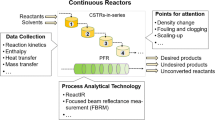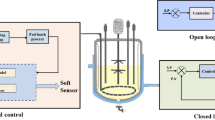Abstract
An optimal control methodology for the homogenization of bacterial cells to recover intracellular products is presented. A Fluent computational fluid dynamics (CFD) model is used to quantify the hydrodynamic forces present in the homogenizer, and empirical models are used to relate these forces to experimentally obtained cell disruption and product recovery data. The optimal homogenizer operation, in terms of either constant cell breakage or maximum intracellular product recovery, is determined using these empirical models. We illustrate this methodology with an Escherichia coli bacterial system used to produce DNA plasmids. Homogenization is performed using an industrial APV–Gaulin high-pressure homogenizer. The modeling and optimization results for this E. coli–DNA plasmid system show good agreement with the experimental data.














Similar content being viewed by others
Abbreviations
- d :
-
Impact distance (mm)
- f c :
-
Total fraction of broken cells
- f f :
-
Fraction of cell breakage due to channel forces
- f τ :
-
Fraction of cell breakage due to shear stress
- f r :
-
Fraction of cell breakage due to impact ring impingement
- g f :
-
Plasmid in the homogenizer feed pellet (g)
- g h :
-
Plasmid in the homogenate pellet (g)
- h :
-
Gap space (μm)
- L :
-
Channel length (m)
- P :
-
Operating pressure (psig)
- P r :
-
Impact ring pressure (psig)
- Q :
-
Volumetric flow rate (ml/s)
- r p :
-
Fraction of free plasmid recovered from homogenization
- β :
-
Proportionality constant
- ΔE:
-
Post-channel turbulence energy dissipation rate (m/s)
- ΔPc:
-
Pressure drop across the channel (psi)
- ΔPi:
-
Channel inlet pressure gradient (Pa/m)
- μ :
-
Viscosity (cp)
- ρ :
-
Fluid density (g/ml)
- τ m :
-
Maximum channel shear stress (psi)
- τ w :
-
Fully developed channel wall shear stress (psi)
References
Miller J, Rogowski M, Kelly W (2002) Using a CFD model to understand the fluid dynamics promoting E. coli breakage in a high-pressure homogenizer. Biotechnol Prog 15(5):1060–1067
Kelly W (2003) Perspectives on plasmid-based gene therapy: challenges for the product and the process. Biotechnol Appl Biochem 37:219–233
Clemson M, Kelly W (2003) Optimizing alkaline lysis for DNA plasmid recovery. Biotechnol Appl Biochem 37:235–244
Brookman J (1974) Mechanism of cell disruption in a high-pressure homogenizer. Biotechnol Bioeng 16:371–383
Kleinig A, Middleberg A (1996) The correlation of cell disruption with homogenizer valve pressure gradient determined by computational fluid dynamics. Chem Eng Sci 51:5103–5110
Middleburg A, O’Neill B (1994) A simplified model for the disruption of Escherichia coli: the effect of cell septation. Biotechnol Prog 10:109–113
Shamlou PA, Titchener-Hooker NJ (1995) A physical model of high-pressure disruption of Baker’s yeast cells. Chem Eng Sci 50:1383–1391
Doulah M, Brookman J (1975) A hydrodynamic mechanism for the disintegration of Saccharomyces cerevisiae in an industrial homogenizer. Biotechnol Bioeng 17:845–858
Engler C, Robinson C (1981) Disruption of Candida utilis cells in high-pressure flow devices. Biotechnol Bioeng 23:765–780
Keshavarez-Moore E (1991) New findings on fundamentals of cell disruption in high pressure homogenizers. In: Biological Recombinant—Microorg. Amin Cells. pp 27–92
Carlson A, Jem K (1995) Mechanical disruption of Escherichia coli for plasmid recovery. Biotechnol Bioeng 48:303–315
Agerkvist I, Enfors S (1990) Characterization of E. coli cell disintegrates from a bead mill and a high pressure homogenizers. Biotechnol Bioeng 36:1083–1089
Steveson M, Chen X (1997) Visualization of the flow patterns in a high-pressure homogenizing valve using a CFD package. J Food Eng 33:151–165
Shih T, Zhu J (1995) A new k–ε eddy viscosity model for high Reynolds number turbulent flows—model development and validation. Comp Fluids 24:227–238
McCabe W, Smith J, Harriott P (1993) Unit operations of chemical engineering, 5th edn. McGraw-Hill, New York
Acknowledgements
We would like to thank APV–Gaulin for providing technical and financial support for this work. We would also like to acknowledge the contributions of Justin Miller, Mark Rogowski, and Mike Clemson in obtaining the Fluent simulation and experimental homogenizer results in this paper.
Author information
Authors and Affiliations
Corresponding author
Rights and permissions
About this article
Cite this article
Kelly, W.J., Muske, K.R. Optimal operation of high-pressure homogenization for intracellular product recovery. Bioprocess Biosyst Eng 27, 25–37 (2004). https://doi.org/10.1007/s00449-004-0378-9
Received:
Accepted:
Published:
Issue Date:
DOI: https://doi.org/10.1007/s00449-004-0378-9




